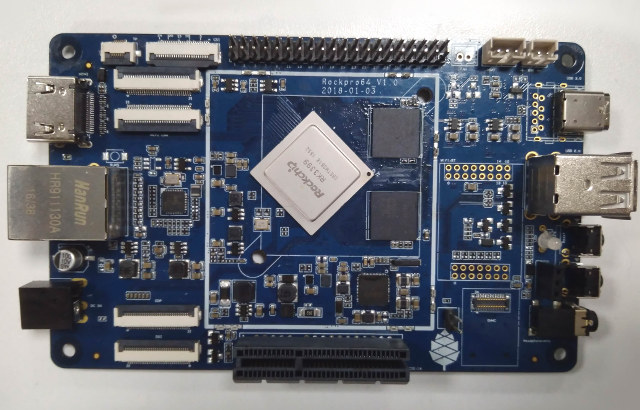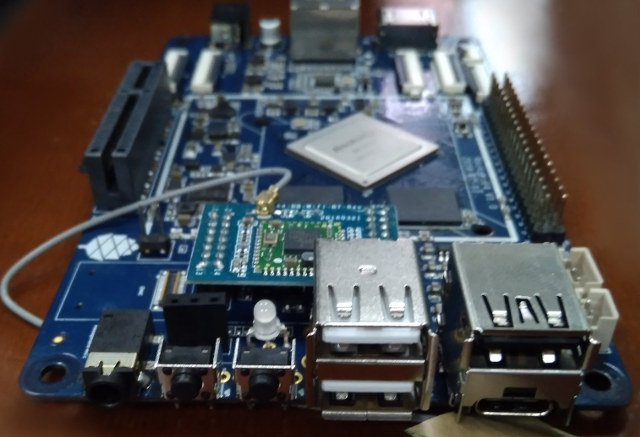Several Rockchip RK3399 boards have been announced in the last few days, first with AAEON RICO-3399 Pico-ITX single board computer targeting mostly business customers for digital signage, kiosk or, automation and Orange Pi RK3399, a featured-pack board with plenty of interfaces to play with.
However those boards, and the one released previously, tend to cost between $100 and $200 or over, and even though we saw Rockchip SAPPHIRE evaluation board going for $75 its was a time-limited promotion, and the normal price is around $150. I’m pleased to report Pine64 will soon launch RockPro64 boards powered by Rockchip RK3399 or the recently announced RK3399Pro with an NPU for around $60 and up.

There will be three versions of the board that will only differ by the processor, or RAM capacity:
- SoC (one or the other)
- Rockchip RK3399 hexa-core processor with 2x ARM Cortex A72 cores up to 2.0 GHz, 4x Cortex A53 cores, and an Arm Mali-T860 MP4 GPU
- Rockchip RK3399Pro hexa-core processor with 2x ARM Cortex A72 cores up to 2.0 GHz, 4x Cortex A53 cores, an Arm Mali-T860 MP4 GPU, and a Neural Network Processing Unit (NPU)
- System Memory – 2 or 4 GB LPDDR3, dual channel
- Storage – eMMC flash module, micro SD card (bootable), 128 Mbit SPI flash
- Video Output & Display Interfaces – HDMI 2.0 output, eDP connector, MIPI connector + TP connector + backlight supply, DisplayPort via USB type C
- Audio – ES8316 Audio Codec; Headphone/MIC jack
- Connectivity – Gigabit Ethernet, SDIO socket for WiFi and Bluetooth module
- USB – 2x USB 2.0 host ports, 1x USB 3.0 port, 1x USB 3.0 type C port with DisplayPort Alt-mode
- Camera – Parallel CSI, 2x MIPI CSI
- Debugging – 3-pin serial header
- Expansion
- 40-pin GPIO header (I2C/SPI/I2S/UARTs/GPIOs)
- PCIe x4 slot
- Misc – Heatsink mounting holes + FAN header, Power/Reset/Recovery buttons, IR receiver
- Power Supply – 12V DC input via power barrel jack 12V/3A recommended for most case. 12V/5A may be needed for power hungry PCIe card
- Dimensions – 133mm x 80mm x 19mm (Same as Pine64 board)

The board will support Android and Linux distributions. One positive is that the PCIe interface is actually exposed, and cost-down has been achieved partially but not including storage, nor wireless module by default, and install rely on either a micro SD card or eMMC flash module to boot the operating systems, and external wireless module for WiFi and Bluetooth.
RK3399 based Rockpro64 will launch on March 15 for $59 to $65 with 2GB RAM, and $79 with 4GB RAM, while Rockpro64-AI should start selling on August 1, 2018 for $99 with RK3399Pro and 4GB RAM. The company is also planning to launch Pine64 H64 board powered by Allwinner H6 processor, but I’ll have a look at little later, especially official launch is planned for January 31, 2018 (in two days).
Thanks to q-bert and nobe for the tip.

Jean-Luc started CNX Software in 2010 as a part-time endeavor, before quitting his job as a software engineering manager, and starting to write daily news, and reviews full time later in 2011.
Support CNX Software! Donate via cryptocurrencies, become a Patron on Patreon, or purchase goods on Amazon or Aliexpress




